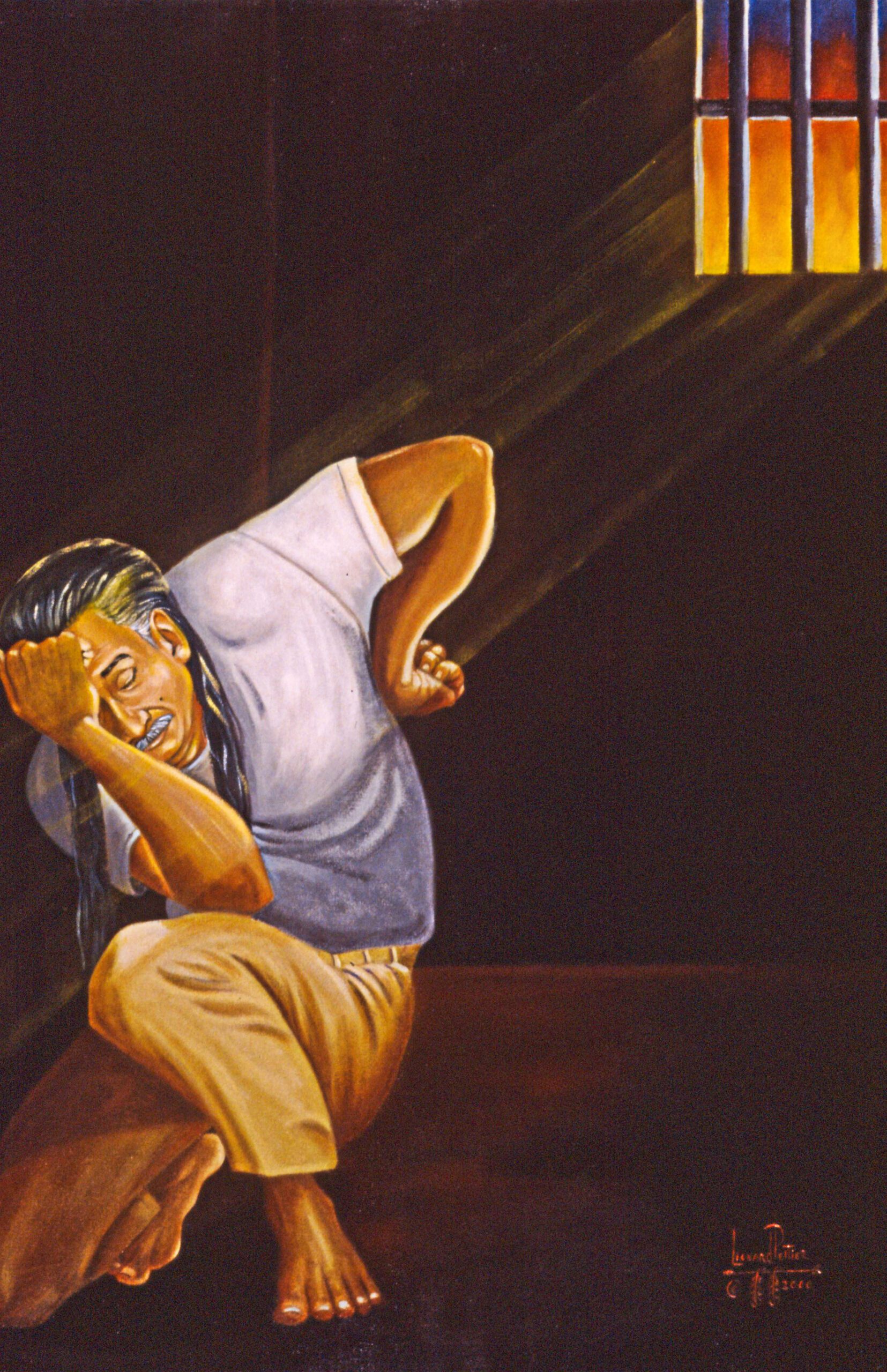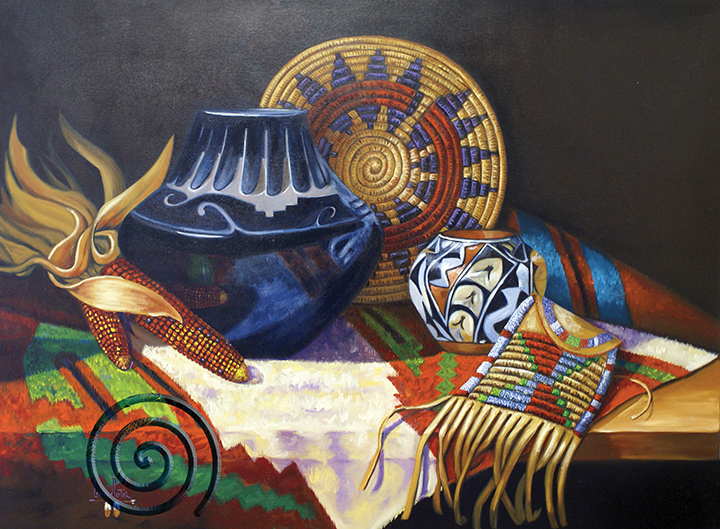We shall live again: 15 more years for Leonard Peltier
Crow’s brought the message
To the children of the sun
For the return of the buffalo
And for a better day to come
You can kill my body
You can damn my soul
For not believing in your God
And some world down below
You don’t stand a chance against my prayers
You don’t stand a chance against my love
They outlawed the Ghost Dance
But we shall live again, we shall live again
-Ghost Dance by Robbie Robertson
COLEMAN, Florida – July 2, 2024 was the date the world received the message that political prisoner Leonard Peltier would be denied parole one more time. This heartbreaking news was expected but that expectation did little to massage the blow to Leonard and those who love and care about him.
Leonard is not in good health. His vision is going and he is almost blind in one eye. He has tremendous arthritis and needs a walker to get around. Diabetes, an aneurysm and other maladies trouble him daily. Leonard has been in prison for almost fifty years and at the age of 79, he is running out of time. The parole board handed down another 15 years to be served until another full parole hearing in 2039. It was scheduled with a caveat that their next status conference with Leonard will be in June of 2026. He may not be alive by then.
Peltier has declared his innocence from the time of his trial in 1977 right up to his parole hearing on June 10, 2024. For his world-wide community of supporters, their highest desire is for him to be able to spend his last years with his family and friends, enjoying the time he has remaining as a free man at the home waiting for him in Turtle Mountain.
This article is not meant to rehash his recent parole hearing on June 10, 2024 or write about what a lawyer said or did not say. The goal here is to let some of the people who know him best share their thoughts and experiences with Leonard beginning with the days before the shooting of AIM member Joe Stuntz and two FBI agents on the Jumping Bull Ranch in Oglala on June 26, 1975.
American Indian Movement member David Hill first met Leonard Peltier in 1972 at the standoff in Washington, DC at the Office of the Indian Affairs Commission which had been taken over at that time by the American Indian Movement. They exchanged a few words then and one additional time before the opportunity came for them to truly get to know each other and become life-long friends. David was mainly working with AIM co-founder Dennis Banks and so was Leonard.
David Hill had a day job at the Indian Center in Rapid City, South Dakota. A program of activities was developed including a community garden which Leonard helped to build. David stressed that Leonard was a regular Native American man who was happy to help you fix your car or build your house. He was a good carpenter and a good mechanic. He helped people get clean of addiction problems. He was a good, strong Indian man, a stand-up guy. If Leonard said he would do something, he did it. He did not believe in bullying. He has a wonderful sense of humor but he would not pick on people or make fun of them. He was consistently called to do what truth asked of him.
Leonard stands for the earth and for nature. He stands for living in harmony with the earth and each other. He has lent his name to countless causes and provides statements and inspiring words for everything that resonates with him. Leonard Peltier walks his talk.
David Hill had been at work at the Indian Center in Rapid City at the time of the shootout at the Jumping Bull Ranch. Dennis Banks was in court for the charges against him for the disruptive protest in Custer at that same time. Both he and David missed the gun fire and murder of American Indian Movement member Joe Stuntz and FBI Agents Williams and Coler.
David Hill compares Leonard Peltier to Martin Luther King Jr., to Gandhi, and others who have sacrificed themselves for their people and humanity. David and Leonard share the belief that every person needs to make up their own mind and give life their best shot. David and many others believe that Leonard has become not only a symbol but a threat to Indigenous people to not step out of line or challenge the establishment. Multiple people stated that once Leonard is gone, someone else will need to take his place as an example of what the result would be for those who confront authority.
Another Peltier friend of more than fifty years is Paulette Dauteuil-Robideau, who ran Leonard’s defense committee for many years and is currently the treasurer of his ad hoc committee. Paulette pointed out that the recent parole board did approve Leonard to be moved to a medical facility which, hopefully, will be closer to his family.
They met in the early 70s at the Trail of Broken Treaties. At that time, Paulette was living in Chicago and Leonard would travel from Milwaukee for the small fundraisers she and a community of activists would hold for him. They kept in touch for several years until a long stretch of time without word indicated to Paulette that something had happened.
Dino Butler and Paulette’s future husband Bob Robideau were charged and released. The jury had determined that they were protecting themselves at the Jumping Bull shootout and they had a right to self-defense. Though Paulette was in Cuba at the time, everyone felt confident that Leonard would be found not guilty just like Dino and Bob. That was not the case and even on appeal with a charge of aiding and abetting, Leonard was found guilty. This decision flew in the face of ballistic defense evidence which clearly showed that Leonard was not the shooter.
Paulette visited Leonard in prison on a daily basis when it was allowed. He was brought from Leavenworth to Terminal Island prison in Los Angeles. Paulette was working as a paralegal at that time. Leonard had received word that there was to be an assassination attempt on his life so he decided to escape. He was on the outside for four or five days when the police picked him up and returned him to Terminal Island.
Dino Butler, Bob Robideau and Dennis Banks raised a half million dollars for Leonard’s defense and for feeding supporters and maintaining the defense house where his supporters were staying. People came from all around the country to support him and even Standing Deer, the Indigenous prisoner who agreed to kill Leonard, had a change of heart due to the depth of Leonard’s spirit of forgiveness. He began to walk the Red Road. Ceremony was performed regularly to keep Leonard’s emotions high including the Sunrise Ceremony where a person of each of the four colors, black, white, yellow and red, stood facing the four directions to pray and walk around the prison. Some people walked around the prison all day long as a form of prayer. The women who did not go to court would cook for everyone and medicine man Leonard Crow Dog would say prayers. Buffy St. Marie performed benefit concerts as fundraisers. No drinking or drugs were allowed. Everyone involved was honoring the sacred practices of Indigenous culture and spirituality.
Leonard had the support of other political prisoners such as Tom Manning, Mike Africa Sr., and Sundiata Acoli to name a few who all knew Leonard for 50 years. Leonard testified that he feared for his life which was why he escaped. He was asked in court why he did not go to the warden. His response was that he feared for his life and questioned how he could trust the prison administration when an assassination on his life had been organized.
David Hill drove Paulette to Florida to set up the defense house for Leonard Peltier in Tampa in order to be close to him when he was transferred to Coleman Federal Correctional Complex. She calls Leonard Peltier a defender of his people, a funny man with a dry Indian humor who could accept criticism from his Elders.
Leonard and Paulette’s husband Bob Robideau were first cousins, born two years apart. They were like brothers. Bob bought Leonard’s son Chauncey his first car. Chauncey and his sister lived with Paulette and Bob for a while. They also helped Leonard’s relatives to come visit him in prison.
While in prison, Leonard began to practice his spirituality by working with Lenny Foster. His spiritual life has given him the tools to withstand the profound hardships and isolation imposed on him by the prison industrial complex.
For decades, Leonard Peltier has developed his skills as an artist. Working with images from Native traditions along with photographs of friends and family, Leonard has developed his own personal style as a painter which is easily recognizable.
In an interview published in New Observations Magazine in 2020, Leonard tells us his thoughts in his own words which were transcribed by Paulette Dauteuil-Robideau at a visit with Leonard in Coleman Prison:
- What is the legacy you want to be remembered for?
- Through the struggle and perseverance for my people since an early age I developed my life-view. I want to be remembered for my leadership for the struggle of Native Nations and all poor people and to ensure human rights for future generations, and of course, Nation Sovereignty to protect Mother Earth.
- How has your creativity helped you to deal with your incarceration?
- My art gives me moments of freedom and it allows my creative section of the mind to sharpen my craft of painting and writing. My art stems from the personal experience of living with my people, and their creative ability expressing our history through Art.
Because his arthritis is now at an extreme level, Leonard can longer paint or even sign his name. His condition has taken away two of the true pleasures he has had in prison, ones that confirm to him that he is alive: painting and writing.
Is this a man who should be in prison for 50 plus years? Anyone with any compassion and understanding would say “No.” The time is long overdue for Indigenous people to organize and create and Indigenous voting block. With a goal of collecting one million signatures from the members of over 500 Federally recognized tribes, the support for Leonard’s release might well be heard.
Fifteen years is a long time. May Tunkasila come to Leonard’s defense.
(Contact Mia Feroleto at mia.feroleto@gmail.com)
The post We shall live again: 15 more years for Leonard Peltier first appeared on Native Sun News Today.


